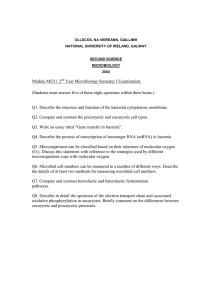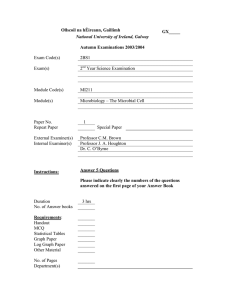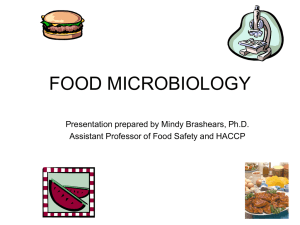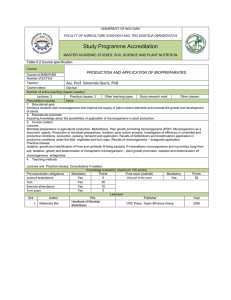Methods for Recovery of Microorganisms and
advertisement
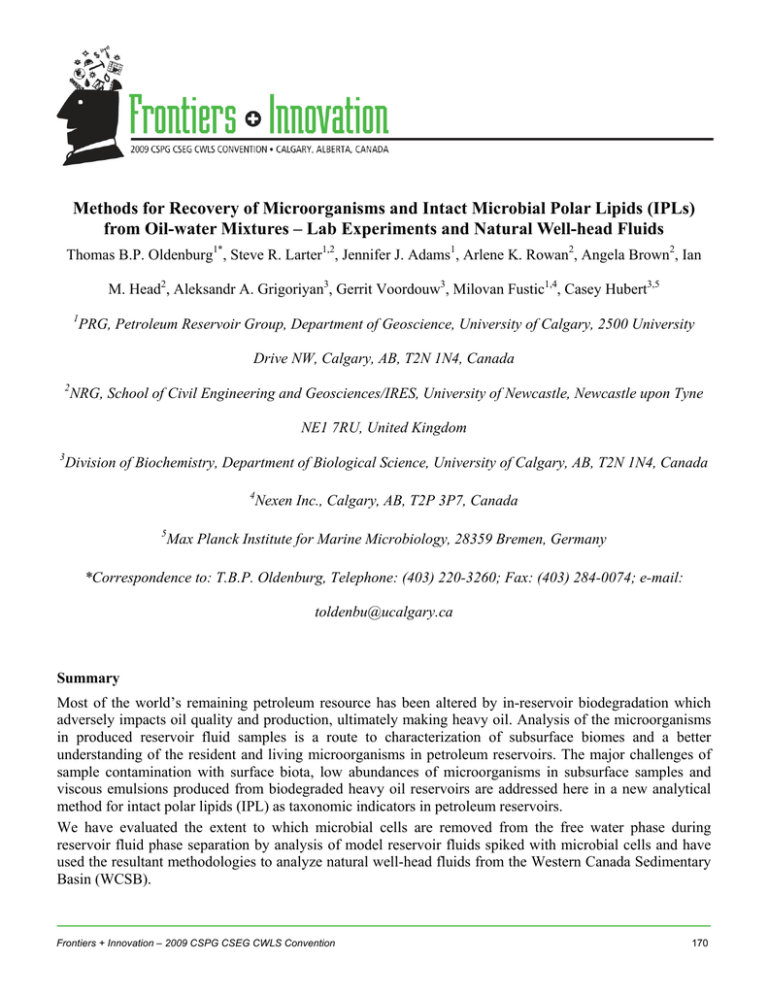
Methods for Recovery of Microorganisms and Intact Microbial Polar Lipids (IPLs) from Oil-water Mixtures – Lab Experiments and Natural Well-head Fluids Thomas B.P. Oldenburg1*, Steve R. Larter1,2, Jennifer J. Adams1, Arlene K. Rowan2, Angela Brown2, Ian M. Head2, Aleksandr A. Grigoriyan3, Gerrit Voordouw3, Milovan Fustic1,4, Casey Hubert3,5 1 PRG, Petroleum Reservoir Group, Department of Geoscience, University of Calgary, 2500 University Drive NW, Calgary, AB, T2N 1N4, Canada 2 NRG, School of Civil Engineering and Geosciences/IRES, University of Newcastle, Newcastle upon Tyne NE1 7RU, United Kingdom 3 Division of Biochemistry, Department of Biological Science, University of Calgary, AB, T2N 1N4, Canada 4 5 Nexen Inc., Calgary, AB, T2P 3P7, Canada Max Planck Institute for Marine Microbiology, 28359 Bremen, Germany *Correspondence to: T.B.P. Oldenburg, Telephone: (403) 220-3260; Fax: (403) 284-0074; e-mail: toldenbu@ucalgary.ca Summary Most of the world’s remaining petroleum resource has been altered by in-reservoir biodegradation which adversely impacts oil quality and production, ultimately making heavy oil. Analysis of the microorganisms in produced reservoir fluid samples is a route to characterization of subsurface biomes and a better understanding of the resident and living microorganisms in petroleum reservoirs. The major challenges of sample contamination with surface biota, low abundances of microorganisms in subsurface samples and viscous emulsions produced from biodegraded heavy oil reservoirs are addressed here in a new analytical method for intact polar lipids (IPL) as taxonomic indicators in petroleum reservoirs. We have evaluated the extent to which microbial cells are removed from the free water phase during reservoir fluid phase separation by analysis of model reservoir fluids spiked with microbial cells and have used the resultant methodologies to analyze natural well-head fluids from the Western Canada Sedimentary Basin (WCSB). Frontiers + Innovation – 2009 CSPG CSEG CWLS Convention 170 Analysis of intact polar membrane lipids (IPL) of microorganisms using liquid chromatography – mass spectrometry (LC-MS) techniques revealed that more than half of the total number of microorganisms can be recovered from oil-water mixtures. A newly developed oil/water separator allowed for filtering of large volumes of water quickly while in the field, which reduced the chances of contamination and alterations to the composition of the subsurface microbial community after sample collection. This method makes the analysis of IPLs (or indirectly microorganisms) from well-head fluids collected in remote field settings possible and reliable. To the best of our knowledge this is the first time that IPLs have been detected in well-head oil-water mixtures. Introduction Biodegraded oils dominate the world petroleum resources with the largest reserves found in Canada and Venezuela1. A significant proportion of petroleum in conventional oil reservoirs is biodegraded and future oil discoveries are also expected to have been altered by microorganisms2. Hydrocarbon biodegradation proceeds in any petroleum reservoir that has a water leg and has not been heated to temperatures over 80ºC, and takes place predominantly at the oil-water transition zone3-4. While microbial activity in deep subsurface reservoirs has been known for over 80 years5, relatively little is known about microbial populations responsible for hydrocarbon degradation. A better understanding of the microbial ecology of these environments, their physiological properties and the reaction systematics of biodegradation will aid both oil exploration and production. While many studies have characterized microbial communities in petroleum reservoirs using both cultivation and culture-independent methods2,6-12, reservoir contamination and low abundances of microorganisms in subsurface environments, especially petroleum reservoirs, are major obstacles to studying these organisms. Sampling petroleum reservoirs for subsurface microbial populations is prone to contamination with non-reservoir microbes from drilling mud, injected water and/or biocide application during production. In an uncontaminated setting, reservoir core samples from the oil-water transition zone of biodegraded petroleum reservoirs have yielded higher levels of metabolites characteristic of anaerobic hydrocarbon biodegradation13 than from the oil saturated reservoir rock. However, culturing microbes can be challenging as in commercial operations in biodegraded petroleum systems like the Alberta tar sands core samples are often frozen immediately upon sampling, or core is not available from biodegradation zones. Analysis of formation water is a viable alternative, however highly biodegraded oil reservoirs often yield produced fluids that are foamy water-oil emulsions. These mixtures typically separate at surface, although some can take days or high temperatures to separate, during which the microbial communities may be altered or destroyed. Recent developments in LC-MS techniques now allow us to detect relatively low concentrations of biomass as IPL. The natural abundance of microorganisms in deep oil reservoirs is very low. Thus the microbial material must be concentrated to use LCMS techniques. PCR amplification is one highly sensitive method which can be used to detect microorganisms in samples with low biomass such as petroleum reservoir samples. However when biomass levels are low the amount of DNA that can be extracted from samples is also low. For this reason when highly sensitive PCR assays are conducted using primers that target sequences present in the majority of bacteria, low levels of DNA present in the reagents used can often lead to false positives and difficulties in reliably identifying the organisms present in the original samples14. Furthermore in heavily degraded oil-water emulsions it is uncertain into which phase the microorganisms partition during separation. Here we describe methods to evaluate the partitioning of microbial cells between oil and water after phase separation from experimental oil-water mixtures. In addition, we discuss the distribution of intact polar lipids in natural heavy oilfield waters, including highly viscous oil-water emulsions from well-heads of heavily biodegraded oil reservoirs in Western Canada. Frontiers + Innovation – 2009 CSPG CSEG CWLS Convention 171 Theory and/or Method Microorganisms An oil field produced-water isolate, Desulfovibrio sp. strain Lac6 [U46522 ("clone DVIB57")]15 was grown in saline Postgate's medium C16-17 and used to inoculate fluid mixture experiments. Sampling Well-head fluid samples were collected from several wells from two oilsand fields (Peace River area and north of Fort McMurray, both Alberta, Canada). To minimize common contamination issues, all samples collected had to pass the following criteria: a.) The well had been continually on production for a long time before sampling, b.) no water or chemicals had been injected into the reservoirs, c.) production was from a single reservoir interval (no commingled oil), d.) samples were only taken from well-heads, i.e. no separator fluids were taken, and e.) only wells with water cuts (percentage of water in the sampled fluid) higher than 70% were considered. For each well, the wellhead valves were flushed prior to sampling. The well-head fluids from the Peace River area were collected into custom designed 27 L sterile separator cans. These cans were specially designed to allow the well-head samples to separate and to sub-sample from the water phase to obtain ca. 20 L of water. The water was subsequently filtered through a 0.2 μm pore-size sterile PTFE filter using a N2 pressured ‘Hazardous Waste Filtration System’ from Millipore Corporation, U.S.A. and the filters were stored in a freezer prior to freezedrying. The procedure to extract the intact polar lipids from the microbial cells is the same as described below for the lab experiments. Natural well-head fluid samples were collected from the Peace River area, Alberta, Canada (Fig. 1A) from wells producing highly biodegraded oil where oil chemistry showed microbial action. A previous study18 indicated that oils in the Peace River area can be geographically divided into a highly biodegraded oil -east of a NW–SE line (Figure 1A), coincident with the 80°C maximum burial isotherm in the Bluesky Formation reservoir. The sharp decline in level of oil biodegradation to the west was interpreted as an indication of reservoir pasteurization shortly after reservoir charging, due to deeper burial of the reservoirs to the west of 80ºC the maximum burial isotherm, which might have limited biodegradation of the western oils. A selection of oils from both sides of the 80°C maximum burial isotherm was sampled to investigate the effect of maximum reservoir temperature on microbial populations in the oil reservoirs. Another set of water samples was obtained from basal aquifers beneath the Athabasca oilsands within 0.5 to 2.0 km of an excavation area at the Muskeg River oilsands, north of Fort McMurray, Alberta, Canada (Fig. 1B). The overlying oilsands are protecting the basal waters from fresh surface water contamination. As the basal waters are in direct contact with the oilsands they can be considered as reservoir oil-water contact (OWC) samples. These water samples didn’t require any separation. The samples were collected in autoclaved brown bottles without headspace and filtered as described above. Experimental approach To determine into which phase the IPL partition after separation of oil-water mixtures, artificial mixtures of microorganisms and oilfield fluids were created with final concentrations of microorganisms similar to amounts typically measured in the subsurface. Approximately 1.7*108 cells (equivalent to 10,000 cells/ml in 17 L water)6 were diluted in 100 ml NaCl-containing phosphate buffer and added to oils to produce six twophase samples with a range of water to oil ratios (Table 1). To simulate emulsions the two-phase samples were treated using three different mixing techniques, i.e. blending, sonicating and shaking (Table 1). The three techniques cover the full range of mixing intensity from soft two-phase contact mixing (shaking) to vigorous emulsification by high speed blending. The temperatures of the fluids never exceeded 50ºC during the experiments. The soft mixing experiments were carried out using a shaker for four hours at 30ºC and 170 rpm. An ultrasonic probe sonicated the samples with a pulse mode of 50% and 35 W for 8 min at 25ºC which was the best compromise between complete mixing without destroying the microorganisms. The high Frontiers + Innovation – 2009 CSPG CSEG CWLS Convention 172 speed stirring experiments were performed with a blender (Waring, New Hartford, CT, USA). To produce good emulsions, the oil was first blended alone for 5 min at approximately 20,000 rpm. After adding the microorganisms-spiked water, the mixture was stirred for another 5 min at approximately 17,000 rpm and 50ºC until only one foamy phase remained. Of all the methods used, the emulsions generated by blending most closely resembled natural well-head fluids but destruction of microbial cells during blending cannot be ruled out. The fluid mixtures were allowed to separate for 4 h at 4ºC to minimize microbial growth during phase separation. A external standard (microorganisms-spiked water) was treated in the same way as all water phases after the experiments and used to estimate cell recovery for each of the experimental treatments. Conclusions Experiments to assess the recovery of intact membrane lipid/microorganisms from oil-water mixtures revealed that in produced oil-water mixtures more than half of the sampled indigenous microbial community can be expected to be detected from the water phase after phase separation. The higher the water to oil ratio and the more unstable the produced emulsion, the higher the percentage of microorganisms recovered after phase separation. IPLs were identified in basal waters from below the Athabasca oilsands and reservoir well-head fluids from the Peace River area. Extreme emulsions are still a challenge for detection of microbial membrane lipids as was the case for two highly biodegraded oils produced as stable emulsions from Peace River oil fields. This intact polar membrane lipid analysis on natural well-head fluids has developed a method to identify microorganisms occurring in oil reservoirs at the oil-water contact zone, to distinguish between archaeal and bacterial microorganisms and their relative quantity. Due to the lack of an extended database of IPL content of a taxonomically representative range of organisms, and the innately limited taxonomic resolution offered by IPL analysis, IPL analysis only provides a first order indication of the microorganisms present. However, as the inventory of IPL data from different organisms grows this approach will be able to offer more detailed information about the composition of natural microbial communities. Acknowledgements The work was encouraged and supported by the Bacchus2 Consortium who are thanked: Agip ENI, BP, Chevron, ConocoPhillips, Norsk Hydro, Petrobras, Saudi Aramco, Shell, Statoil, Total, Woodside. Albian Sands Energy Inc. gratefully supported this project by allowing us to sample the basal waters. References (1) Roadifer, R.E. In Exploration for heavy crude oil and natural bitumen, AAPG Studies in Geology 25; Meyer R.F., Ed.; 1987; 3-23. (2) Head, I.M., Jones, D.M., Larter, S.R. Nature 2003, 426, 344. (3) Wilhelms, A., Larter, S.R., Head, I., Farrimond, P., di-Primio, R., Zwach, C. Nature 2001, 411, 1034. (4) Larter, S., Huang, H., Adams, J., Bennett, B., Jokanola, O., Oldenburg, T., Jones, M., Head, I., Riediger, C., Fowler, M. AAPG Bulletin 2006, 90, 921. (5) Bastin, E. Science 1926, 63, 21. (6) Parkes, R.J., Cragg, B.A., Bale, S.J., Getlifff, J.M., Goodman, K., Rochelle, P.A., Fry, J.C., Weightman, A.j., Harvey S.M. Nature 1994, 371, 410. (7) Fredrickson, J.K., McKinley, J.P., Nierzwicki-Bauer, S.A., White, D.C., Ringelberg, D.B., Rawson, S.A., Shu-Mei Li, Brockman, F.J., Bjornstad, B.N. Molecular Ecology 1995, 41, 619. (8) Magot, M., Ollivier, B., Patel, B.K.C. Antonie van Leeuwenhoek 2000, 77, 103. (9) Orphan, V.J., Taylor, L.T., Hafenbradi, D., DeLong, E.F. Applied Environmental Microbiology 2000, 66, 700. (10) Pedersen, K. FEMS Microbiology Letters 2000, 185, 9. (11) Van Hamme, J.D., Singh, A., Ward, O.P. Microbiology and Molecular Biology Reviews 2000, 67, 503. (12) Magot, M. In Petroleum Microbiology; Ollivier, B., Magot, M., Eds.; 2005; 21-34. (13) Aitken, C.M., Jones, D.M., Larter, S.R. Nature 2004, 431, 291. (14) Röhling, W.F.M., Head, I.M. In Molecular Microbial Ecology, BIOS Advanced Methods; Osborn, A.M., Smith, C.J., EDs.; 2005; 25-63. (15) Voordouw, G., Voordouw, J.K., Jack, T.R., Foght, J.M., Fedorak, P.M., Westlake, D.W.S. Applied and Environmental Microbiology 1992, 58, 3542. (16) Postgate, J.R. The Sulfate-Reducing Bacteria; 1984; 30–34. (17) Nemati, M., Jenneman, G.E., and Voordouw, G. Biotechnology Bioengineering 2001, 74, 424. Frontiers + Innovation – 2009 CSPG CSEG CWLS Convention 173

